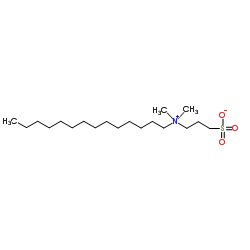3-(N,N-Dimethylmyristylammonio)propanesulfonate

3-(N,N-Dimethylmyristylammonio)propanesulfonate structure
|
Common Name | 3-(N,N-Dimethylmyristylammonio)propanesulfonate | ||
|---|---|---|---|---|
| CAS Number | 14933-09-6 | Molecular Weight | 363.599 | |
| Density | N/A | Boiling Point | N/A | |
| Molecular Formula | C19H41NO3S | Melting Point | 250ºC | |
| MSDS | Chinese USA | Flash Point | >110ºC | |
Use of 3-(N,N-Dimethylmyristylammonio)propanesulfonate3-(N,N-Dimethylmyristylammonio)propanesulfonate is a biochemical reagent that can be used as a biological material or organic compound for life science related research. |
| Name | 3-(N,N-Dimethylmyristylammonio)propanesulfate |
|---|---|
| Synonym | More Synonyms |
| Description | 3-(N,N-Dimethylmyristylammonio)propanesulfonate is a biochemical reagent that can be used as a biological material or organic compound for life science related research. |
|---|---|
| Related Catalog |
| Melting Point | 250ºC |
|---|---|
| Molecular Formula | C19H41NO3S |
| Molecular Weight | 363.599 |
| Flash Point | >110ºC |
| Exact Mass | 363.280701 |
| PSA | 65.58000 |
| LogP | -1.05 |
| Storage condition | 2-8°C |
| Stability | Hygroscopic |
| Water Solubility | H2O: 1 M at 20 °C, clear, colorless |
| Personal Protective Equipment | dust mask type N95 (US);Eyeshields;Gloves |
|---|---|
| Hazard Codes | Xi: Irritant; |
| Risk Phrases | R36/37/38 |
| Safety Phrases | S26-S36 |
| RIDADR | UN 1759 |
| WGK Germany | 3 |
| Precursor 2 | |
|---|---|
| DownStream 0 | |
|
Highly sensitive analysis of flavonoids by zwitterionic microemulsion electrokinetic chromatography coupled with light-emitting diode-induced fluorescence detection.
J. Chromatogr. A. 1358 , 277-84, (2014) A rapid zwitterionic microemulsion electrokinetic chromatography (ZI-MEEKC) approach coupled with light-emitting-diode-induced fluorescence (LED-IF, 480nm) detection was proposed for the analysis of f... |
|
|
Metal complexes as artificial proteases in proteomics: a palladium(II) complex cleaves various proteins in solutions containing detergents.
J. Inorg. Biochem. 105(5) , 675-83, (2011) Most popular agents for site-specific protein cleavage are proteolytic enzymes. Because they become denatured and inactivated by detergents, enzymes are inconvenient for proteomic analysis of hydropho... |
|
|
Electrospray mass spectra of three proprietary detergents.
Anal. Biochem. 285(2) , 205-10, (2000) We have determined the major ingredients of the commercially available reagents M-PER, Y-PER, and B-PER from Pierce Chemical Co. using electrospray mass spectrometry. These three proprietary reagents ... |
| 3-(N,N-Dimethylmyristylammonio)propanesulfonate |
| 3-(N,N-Dimethyltetradecylammonio)propanesulfonate (3-(Myristyldimethylammonio)propanesulfonate |
| Myristyldimethyl(3-sulfopropyl)ammonium Hydroxide Inner Salt |
| Myristyl Sulfobetaine |
| 3-[Dimethyl(tetradecyl)ammonio]-1-propanesulfonate |
| 3-[Dimethyl(myristyl)ammonio]propane-1-sulfonate |
| 1-Tetradecanaminium, N,N-dimethyl-N-(3-sulfopropyl)-, inner salt |
| 3-[dimethyl(tetradecyl)ammonio]propane-1-sulfonate |
| 3-[dimethyl(tetradecyl)azaniumyl]propane-1-sulfonate |
| MFCD00036910 |
| TetradecyldiMethyl(3-sulfopropyl)aMMoniuM Hydroxide Inner Salt |
| EINECS 239-003-9 |
 CAS#:1120-71-4
CAS#:1120-71-4 CAS#:112-75-4
CAS#:112-75-4
